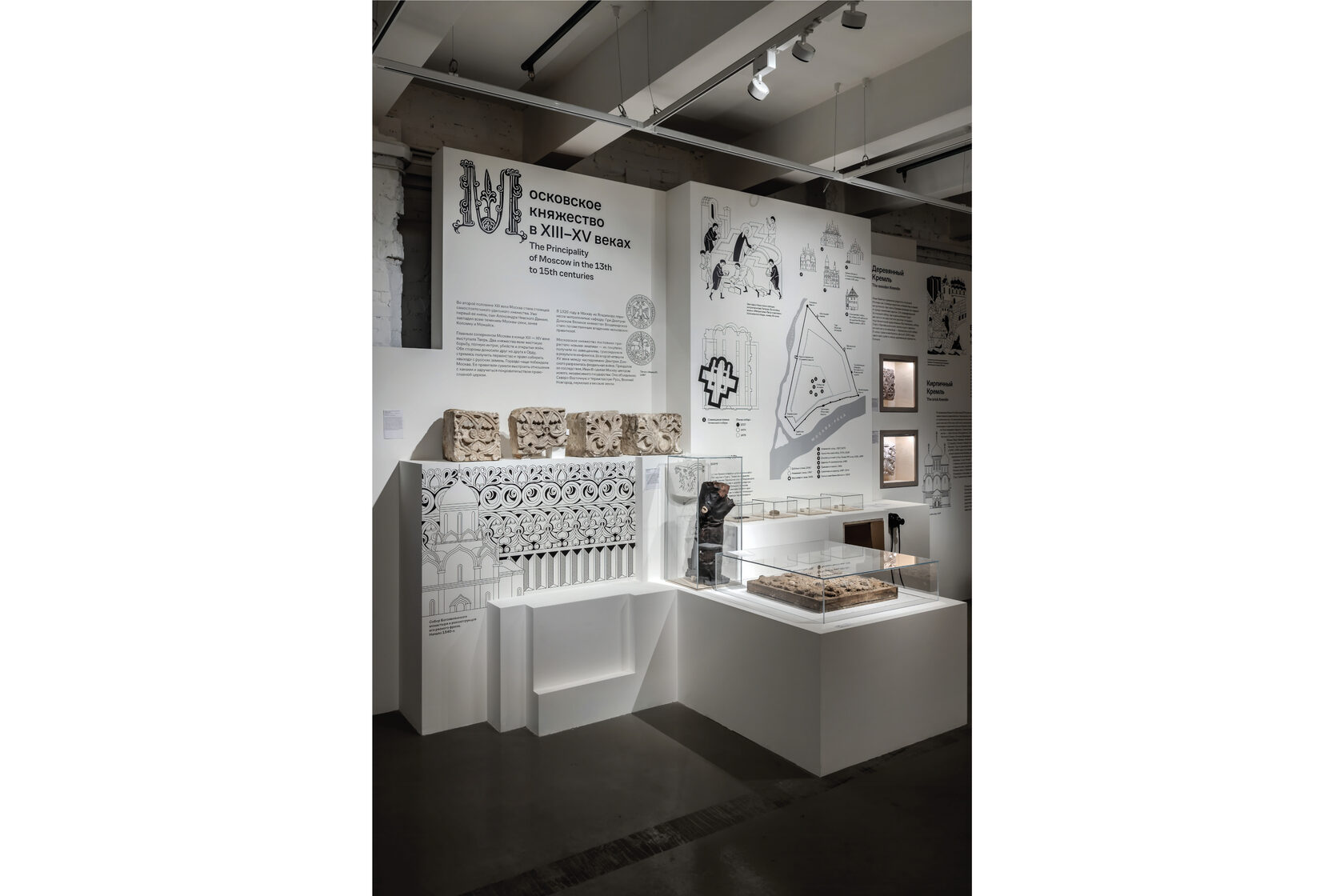This website uses only essential cookies for its basic functioning. It does not collect any personal data.
got it
History of Moscow. Permanent Exhibition Project of the Museum of Moscow
Museum of Moscow
2021–2022
2021–2022
The Museum of Moscow, founded in 1896, had never before presented a permanent exhibition covering the city’s history from ancient times to the present. The 2021 project became the first to encompass the full historical arc of Moscow, including the early settlements that predated its founding. In December 2024, the first part of the exhibition (4th century BCE to 1940), based on this project, officially opened.*
The exhibition occupies 1,300 square meters and is structured in three layers:
The exhibition features 2,200 artifacts and works of art, many of which are being shown at this scale for the first time from the museum’s holdings. Among them are archaeological finds, paintings, prints, photographs, rare books, household objects, decorative arts, and architectural elements.
To create the texts, infographics, maps, and models, the curators collaborated with leading archaeologists, historians, art historians, local historians, and cultural theorists, alongside designers, sculptors, animators, cartographers, and scriptwriters.
Rather than competing with Moscow’s larger history museums in chronicling major national events, the Museum of Moscow chose to focus on the private lives of Muscovites over the centuries. Its mission—to trace intergenerational links, explore everyday urban life, and seek continuity between today’s residents and those who walked the city’s streets 800, 500, or 100 years ago—feels even more vital than presenting a formal narrative of state history.
The chronological section offers a compact overview of the city’s past, showcasing highlights and lesser-known treasures from the collection, with a focus on urban life and shifts in the city’s built environment.
A special layer of the timeline is dedicated to children, following the daily lives of Moscow’s youngest residents from the 12th to the 20th century. Digital elements and intuitive navigation embedded in the timeline allow visitors to dive deeper into specific topics or branch out into other parts of the exhibition—open storage or thematic pavilions.
The open storage presents a large portion of the museum’s holdings in typological and chronological order: for instance, medieval ceramics, a collection of 16th-18th century gravestones, Empire and Neoclassical furniture, firsthand accounts of the War of 1812, product design of the Art Nouveau period, and 1920s-30s views of Moscow, among others.
The rotating curatorial pavilions are updated quarterly or biannually, each one shedding light on a vivid episode from Moscow’s history, interpreted by in-house or guest curators.
*In November 2024, shortly before the exhibition opened, at the request of the authorities (Ministry of Culture and the FSB), the section dedicated to the 1937−1939 repressions was removed by the museum’s leadership.
The exhibition occupies 1,300 square meters and is structured in three layers:
- A historical timeline
- Open storage zones
- Rotating curatorial pavilions
The exhibition features 2,200 artifacts and works of art, many of which are being shown at this scale for the first time from the museum’s holdings. Among them are archaeological finds, paintings, prints, photographs, rare books, household objects, decorative arts, and architectural elements.
To create the texts, infographics, maps, and models, the curators collaborated with leading archaeologists, historians, art historians, local historians, and cultural theorists, alongside designers, sculptors, animators, cartographers, and scriptwriters.
Rather than competing with Moscow’s larger history museums in chronicling major national events, the Museum of Moscow chose to focus on the private lives of Muscovites over the centuries. Its mission—to trace intergenerational links, explore everyday urban life, and seek continuity between today’s residents and those who walked the city’s streets 800, 500, or 100 years ago—feels even more vital than presenting a formal narrative of state history.
The chronological section offers a compact overview of the city’s past, showcasing highlights and lesser-known treasures from the collection, with a focus on urban life and shifts in the city’s built environment.
A special layer of the timeline is dedicated to children, following the daily lives of Moscow’s youngest residents from the 12th to the 20th century. Digital elements and intuitive navigation embedded in the timeline allow visitors to dive deeper into specific topics or branch out into other parts of the exhibition—open storage or thematic pavilions.
The open storage presents a large portion of the museum’s holdings in typological and chronological order: for instance, medieval ceramics, a collection of 16th-18th century gravestones, Empire and Neoclassical furniture, firsthand accounts of the War of 1812, product design of the Art Nouveau period, and 1920s-30s views of Moscow, among others.
The rotating curatorial pavilions are updated quarterly or biannually, each one shedding light on a vivid episode from Moscow’s history, interpreted by in-house or guest curators.
*In November 2024, shortly before the exhibition opened, at the request of the authorities (Ministry of Culture and the FSB), the section dedicated to the 1937−1939 repressions was removed by the museum’s leadership.
Chief Curators
Aleksandra Selivanova
Svetlana Babajan
Curatorial Assistant
Anzhelika Werner
Exhibition Architecture
Kirill Ass
Nadya Korbut
Graphic Design
Anastasia Yarullina
Anna Gutman
Anastasia Liptsis
Aleksandra Selivanova
Svetlana Babajan
Curatorial Assistant
Anzhelika Werner
Exhibition Architecture
Kirill Ass
Nadya Korbut
Graphic Design
Anastasia Yarullina
Anna Gutman
Anastasia Liptsis
Map and Drop Cap Design
Yuri Gordon
Editor-in-Chief
Margarita Lyalinskaya
Photography
Natalia Muschinkina
Olga Alexeenko
Evgenij Smirnov
Yuri Gordon
Editor-in-Chief
Margarita Lyalinskaya
Photography
Natalia Muschinkina
Olga Alexeenko
Evgenij Smirnov

























